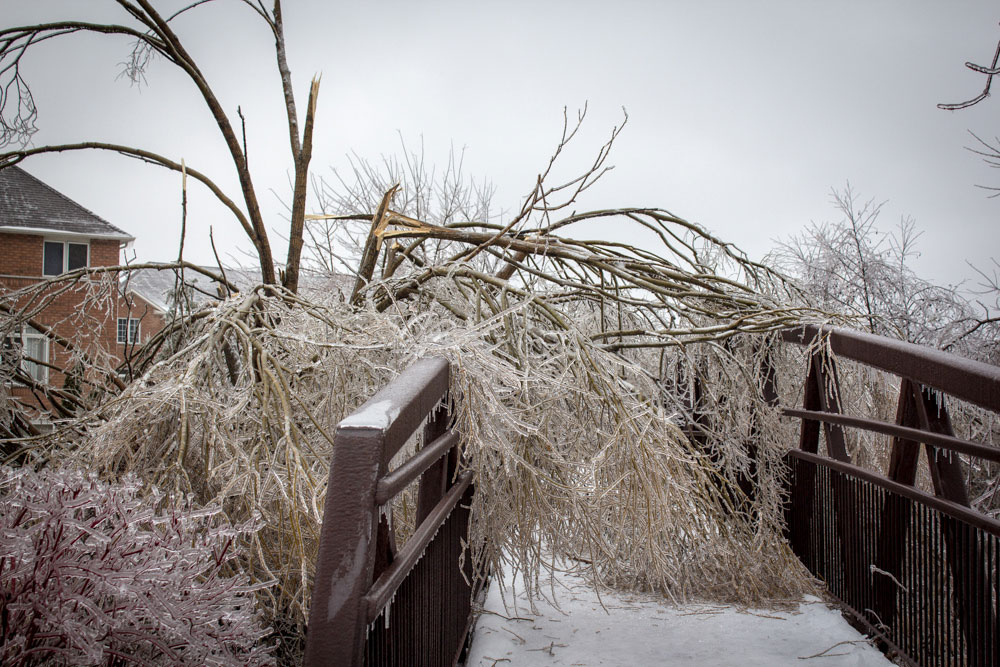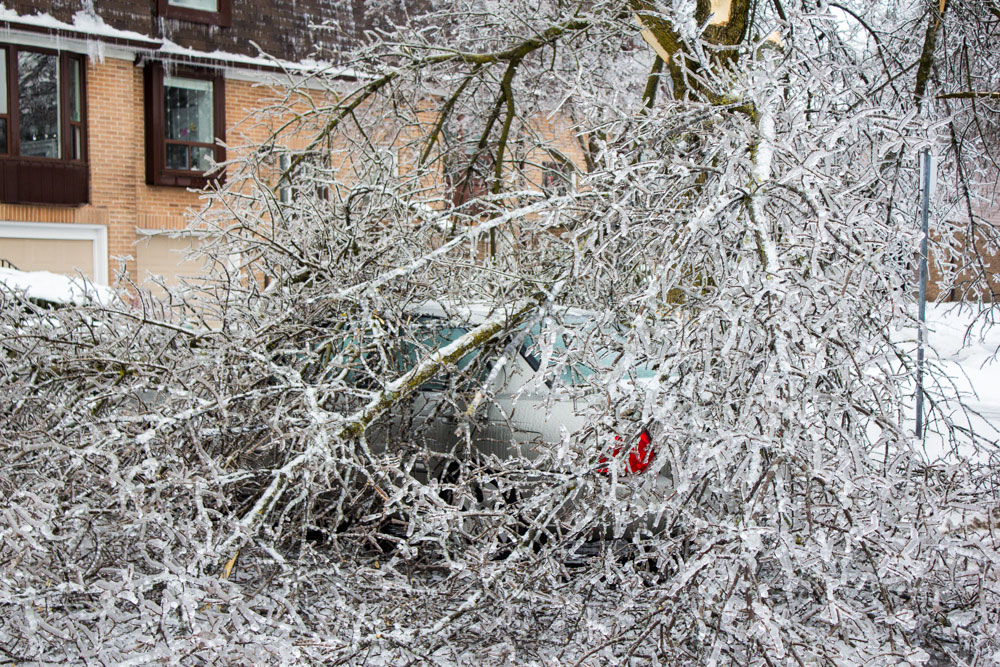TORONTO – Canadians are are no strangers to natural disasters. As one of the largest and most geographically diverse countries in the world, we experience tornadoes, winter storms, floods, even hurricanes.

Toronto has also experienced its own share of natural disasters. So, how does the ice storm compare? Let’s take a look.
Ontario Ice Storm 2013
Cost: Unknown
Though it will be some time before we get a big-picture look at the ice storm totals, here are some preliminary numbers and observations:
Almost 500,000 people across southern Ontario were left without power due to the storm (350,000 Toronto Hydro; 110,000 Hydro One; 29,000 Power Stream; 5,000 Enersource).
Due to ice buildup on cables, the Toronto Transit Commission was forced to suspend all of its streetcar operations on Sunday, the day following the storm. Subway service and bus routes continued to be disrupted on Monday, and hundreds of flights out of Toronto’s Pearson International Airport and the Toronto Billy Bishop Airport were affected, either delayed or cancelled.
On Monday, Toronto Hydro said that some residents may not have power until the weekend — a full week after the storm, and days past Christmas.
With what could be damage to thousands of trees in and around the GTA, the clean-up costs, which are to be determined, could be the costliest in recent memory.
READ MORE: Extreme weather events of 2013
- What is a halal mortgage? How interest-free home financing works in Canada
- Ontario doctors offer solutions to help address shortage of family physicians
- Capital gains changes are ‘really fair,’ Freeland says, as doctors cry foul
- Budget 2024 failed to spark ‘political reboot’ for Liberals, polling suggests
Hurricane Hazel
Cost: (today’s dollars) $1 billion
Between Oct. 5 and Oct. 16, 1954, a hurricane moved up from the tropics. Though people across Ontario were warned of the dangerous storm, many did not heed the advisory.
A rainfall record was set with 121 mm. In the city, 183 mm fell over 24 hours. A total of 4,000 people were left homeless (1,868 in Toronto) and 81 people died. Of that number, 35 died on one street alone (Raymore Drive) as 14 houses were washed away.
Cost (estimated): $1 billion
On July 8, a very moist air mass moved its way up into southern Ontario. Forecasters didn’t issue storm warnings as it was felt that warning criteria would not be met. However, by evening rush hour, it was clear that this rain event was going to be major.
Two storm cells dropped 126 mm of rain at Toronto’s Pearson airport; in the city 96.8 mm fell, most of it between 4:20 p.m. to 6:30 p.m. What made things even more difficult was that the city had experienced 38 mm of rain the day before and city sewers and the ground couldn’t take the sudden deluge.
The foot of the Don Valley Parkway became flooded, leaving residents stranded in their cars. A GO Transit commuter train became stuck on the tracks with hundreds of people trapped. They were rescued hours later by police on boats. About 500,000 households were left without power — some for days — and about 3,000 homes were flooded.
Toronto flood, Aug. 19, 2005
Cost: $642,400,000 (Insurance Bureau of Canada)
On Aug. 19, 2005, a series of severe thunderstorms approached the city from the south, affecting Kitchener to Ottawa and the northern part of Toronto. A rare tornado warning was even issued for the city.
At the height of the storm there were an incredible 1,400 lightning strikes a minute. Flash flooding occurred in Toronto, and one road was even washed out entirely with a sink hole.
Rainfall of 103 mm in an hour occurred in North York and surrounding areas. At an Environment Canada rain gauge, 140 mm rain was recorded (though it is not the official location rain gauge). To compare, Hurricane Hazel dropped 53 mm in an hour in 1954.
READ MORE: Top Ten Weather Stories of 2013
Toronto snow
Cost: $122,000,000
Jan. 13-15, 1999
After 40 cm of snow fell on the city at the beginning of January, another 78 cm fell over three days. The city’s transit system was shut down, leaving millions stranded. Flights at Pearson International Airport were cancelled, and soldiers were called in to help with snow removal. Roughly 7.1 million people across southern Ontario were affected.
Comparing Toronto’s disasters to other provinces’
Alberta Flood 2013
June 20-22, 2013
- $1.6 billion insurable costs
- 100,000 Albertans displaced
- Closure of part of the Trans-Canada Highway
- 4,000 businesses impacted in Calgary alone
- Closure of Calgary Zoo
- Total average rainfall averaged between 75 to 150 mm over two-and-a-half days

Ice Storm of 1998
Costs: Quebec $1.6 billion; Ontario $216 million; Atlantic $25.5 million
- January 4-10, 1998
- 16,000 troops dispatched
- 100 mm of freezing rain in Ottawa
READ MORE: Ice storm
Saguenay flood 1996
July 18 to 21, 1996
Cost: $1.5 billion
- 488 homes destroyed
- 1,230 homes damaged
- 16,000 evacuated
- 155 mm of rain fell (entire month’s worth)
Red River Flood 1997
April 22 to May 14, 1997
Cost: $6 billion
- Spring runoff of 135mm
- 1,840 square km of valley lands flooded
- 25,447 people evacuated
- 7,000 military personnel deployed






Comments